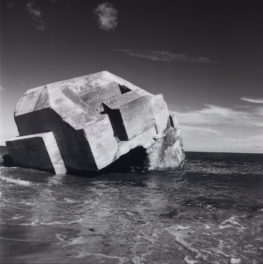Update: video of this lecture is available here.
Amid the moon-like landscape of the Sinai, the Holy Monastery of Saint Catherine has stood unfailing for 17 centuries, unaltered by invasion or conquest. Imagine a place rooted in the ancient world that is also a living community of the 21st century—a place of exquisite beauty, home to some of the oldest surviving icons from the Byzantine world. In 2006 the Getty Museum had the privilege of being the only venue for an extraordinary exhibition of objects from Saint Catherine’s, objects never before seen outside the monastery.
This landmark exhibition grew out of the Getty’s long-standing relationship with Saint Catherine’s, which began with a 1999 project to consolidate and conserve the incomparable sixth-century wall mosaic of the Transfiguration, located in the monastery’s basilica. Conservator and archaeologist Roberto Nardi and his team undertook the conservation of the mosaic, with initial support provided by the Getty Conservation Institute and the Getty Foundation and major funding for the conservation of mosaics coming from the Emir of Qatar.

Mosaic of the Transfiguration in the basilica of the Holy Monastery of Saint Catherine, Sinai. Photo: Robert S. Nelson
After more than a decade of work, the project to conserve and consolidate the Transfiguration mosaic was completed in 2010. Roberto Nardi has traveled to Los Angeles to speak about this project at the Getty Center on April 14.
I asked him about some of the challenges of working in the Sinai:
With the mosaic itself, there were many technical difficulties because of the dramatic state of detachment. In particular, the area around the face of Christ was totally detached from the wall. This area corresponds with the center of the apse, which meant there was also maximum gravitational pull and risk of complete detachment and collapse.
We were also working in a very remote region, on a multi-year project involving a team of 15 conservators, within a monastic community with centuries of tradition and daily practice. All this presented significant logistical and management challenges. And, of course, we were not dealing with an archaeological artifact but with a living work that is in use every day as an instrument of prayer. The mosaic has been at the center of an intense religious life for centuries, venerated by the Sinai monks and by visiting pilgrims. All the work that we did―our technical decisions and methodological principles―had to address this, and input from the monks enriched this process.

Participants at a training course in Tyre, Lebanon, undertake documentation and condition assessments for mosaics. Photo: Leslie Friedman
The Getty Conservation Institute and the Getty Foundation have recently partnered on a regional mosaics-related initiative, MOSAIKON, in collaboration with the ICCROM (The International Centre for the Study of the Preservation and Restoration of Cultural Heritage), and the International Committee for the Conservation of Mosaics (ICCM). The objective is to improve regional expertise in the conservation, maintenance, and preservation of mosaics in museums and at archaeological sites in the Mediterranean region.
Roberto Nardi will lead one of the projects of the MOSAIKON initiative, providing training for technicians in the conservation of mosaics in Syria. I asked him to share his thoughts on the work he will be doing:
This is an initiative that Syria, like other countries in the Mediterranean area, including Italy and Greece, desperately needs and deserves. In the last twenty years, conservation has experienced advances in the areas of management, documentation, and risk assessment. However, actual implementation in the field lags behind. It is more and more difficult to find technicians trained in conservation/restoration practice.
To say it in a simpler way, we have become very good in planning and managing, but lack the human resources technically prepared to implement what is planned. With MOSAIKON, we will fill this gap in Syria with an upcoming course. We hope to start work in Damascus in June 2011.
Join us on Thursday to hear more from Roberto about the fascinating issues surrounding mosaics conservation and to learn the full story of the monumental project to preserve the Transfiguration mosaic.
Thanks to Angela Escobar for her contributions to this post.




some of the Mosaics would long be destroyed with if it wasn’t for intense conservation efforts and initiatives. The mosaic of the transfiguration is one of the finest artwork that i have ever seen(although not visited)and it is indeed worth restoring for future generations.
Great thanks to Getty Conservation Institute